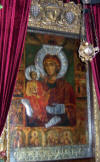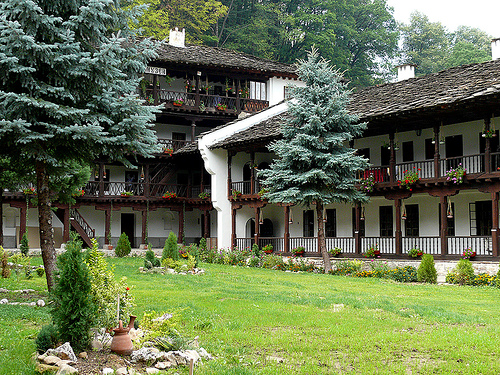
Location: 10 km (6 mi) East of Trojan Map
Found: late 16th century
Tel. (06952) 2866
Open: 8am- 10pm daily
Entrance Fee: free
Camera: 5 lv, video 15 lv
Three- Handed Virgin

Monastery of the Dormition of the Most Holy Mother of God or simply
Troyan Monastery as it is widely known is one of the largest and
most important monasteries in Bulgaria. Troyan Monastery was found
in the late 16th century, however only stone throne in the church
survives from those times. Troyan Monastery have always been the hub
of patriotic and Christian mission in the country conquered and
subjugated by the Muslim Ottomans. In 1872 prominent Bulgarian
freedom fighter Vassil Levsky set up his revolutionary committee in
the Troyan Monastery thus making it the center of the April Uprising
of 1876. Monks of the monastery under leadership of abbot Macarius
did not participate in the military actions against the Turks, but
helped with food, protection and medical care.
The
iconostasis of the main church of Troyan Monastery was carved from
wood in 1839 while the holy alter gate (tsar's gates) of St. Nikola
Chapel date to 1794. The exterior and interior of the church is
painted by famous artist Zahari Zograph between 1847 and 1849 during
Bulgarian National Revival movement. Many of his paintings depict
non canonic beliefs or practices held by his people that did not
contradict teachings of the Bulgarian Orthodox Church such as the
Wheel of Life and Doomsday. Furthermore he managed to slip in both
Bulgarian and Russian saints side by side thus hinting upcoming war
for Bulgarian independence between Ottoman Turkish Empire and
Russian Empire that led to complete defeat of the Turks. If you will
get lucky or will be very pleasant you might see Russian weapons
that were given by the Cossacks as a present to their Slavic
Orthodox brothers of Troyan Monastery. Collection of weapons is
usually kept from tourists, but you can try you luck anyway.
Furthermore you might plan your trip around May 6 which is a Feast
day of St. George, protector of the main church in the Troyan
Monastery. It contains one of the most revered icons in the
Bulgarian Orthodoxy as well as very unusual depiction of Three-
Handed Virgin.
Location
The
monastery, which is the third largest in Bulgaria, is
picturesquely situated on the banks of the Cherni Osam River, in
the village of Oreshak, 10 km from Troyan.
History
It
was founded around 1600 (Abbot Kalistrat), possibly before that.
The legend speaks of monks from Mount Athos who go to Wallachia
with the shrine of the monastery - the miraculous icon of the
Mother of God Troeruchitsa, which is a copy of the old
miraculous icon in the Hilendar Monastery (XIV century). The
Trojan monastery is growing rapidly. Very soon a wooden church
dedicated to the Nativity of the Mother of God, a monastic
residential wing and a small inn were built. Not long after,
however, during the time of Abbot Callistrius of Lovech, the
monastery was defeated by a Turkish gang. The abbot himself was
beheaded.
In the first half of the 18th century the
monastery grew again and became economically wealthy. At that
time, a cell school began to function in it, which after 1765,
when it was taken over by teacher Nikola Varbanov, became more
and more famous. At the same time, the abbot Christopher, a
native of Sopot, carried out the first major constructions in
the monastery. He erected some new buildings and tightened the
wooden church, and in 1771 he built its water supply. Around
1780, another Sopot resident, Abbot Pahomiy, organized the
construction of a new, already stone cathedral.
In a
monastery chronicle, compiled in 1835, it is noted: “The
existence of the Troyan monastery began many years after the
fall of the Bulgarian kingdom. A monk appeared, a Bulgarian,
unknown by name. He came from an unknown country, settled in the
mountain desert with his only student. And by building a simple
hut for himself and living in it for many years, he became known
to the common people in this area.
At the beginning of
the 19th century the monastery was already quite large. The
residential buildings that surrounded the yard are two-storey
and even three-storey - something extremely rare for the era. In
the northwest corner there is a residential and defensive tower.
Most of these buildings were built by Paisius, who after 1785
was abbot for 32 years. His work is also the construction at the
end of the XVIII century of the monastery hermitage "St.
Nicholas the Wonderworker", east of the monastery. One of the
next abbots, Parthenius, erected a new wall in 1820, but the
Dervish Pasha of Vidin accused him of building a fortress to
help Ypsilanti, and he was thrown into the Lovech prison for
several months. On December 4, 1830, after long actions by the
clergy, the Troyan Monastery was recognized as a stauropegial,
directly subordinate to the Constantinople Patriarchate.
In 1832, Parthenius built a new, second hermitage "St. John the
Forerunner", named "Zelenikovets" from the area where it was
built. In the same year, donations were collected for the
construction of a new cathedral. The main donors are x. Petar
Balyuv from Troyan, Spas Marinov, Stoyan Chalakoglu Beylikchi
from Koprivshtitsa, hut Mihail from Teteven and Pencho Popovich
from Tryavna. The Sultan's firman for this construction was made
with the help of Stoyan Beylikchi only in March 1835. The
cathedral was built on the site of an older church by the famous
Revival builder Konstantin from Peshtera. It was consecrated on
August 6, 1835 by Metropolitan Ilarion Tarnovski in honor of the
Assumption of the Blessed Virgin. In 1847-1848 it was decorated
with frescoes by Zachary Zograf, who left on the north inner
wall of the church donor portraits and his self-portrait, as
well as the composition Wheel of Life on the north outer wall.
At the beginning of the 20th century it was repainted by the
Kazanlak artist Petko Ganin. The construction is on a site
located about twenty meters north of the old church, in the area
of the monastery cemetery. Therefore, in the substructure of
the building, under the altar tract, an arched bone storehouse
is formed.
The five-storey monastery tower with a bell
tower is the work of master Ivan (Yonko) Stoynov Kamburov from
Mlechevo (1866). Its demolished parts (1898) were restored in
1987. The residential buildings of the Troyan Monastery are
built of wood in the Revival style.
Vasil Levski founded
a private revolutionary committee here. The monastery was not
directly involved in the April Uprising because Turkish troops
were stationed there. During the Russo-Turkish War of 1877-1878,
the monks and the surrounding population assisted General Pavel
Kartsov's detachment in the transition to the Balkans.